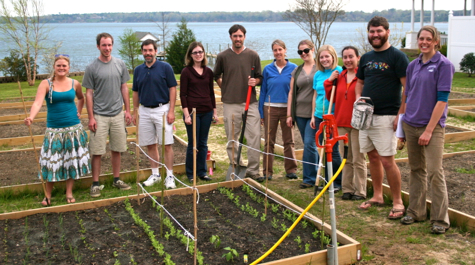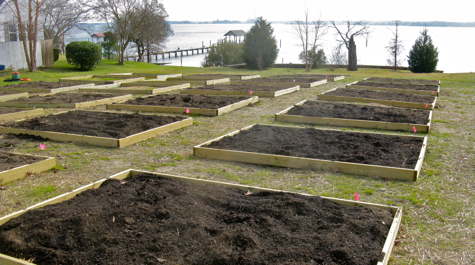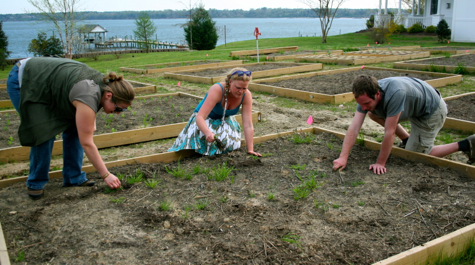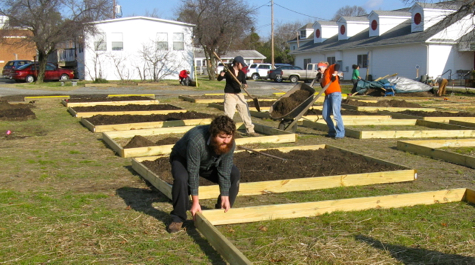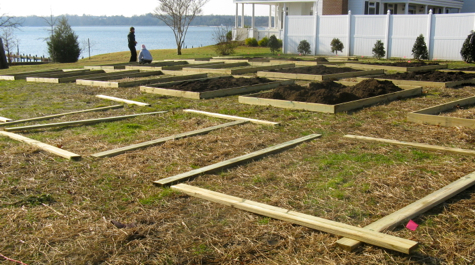VIMS celebrates Earth Day with a new community garden
Graduate students Jenna Luek and Brandon Conroy of the Virginia Institute of Marine Science spend hours in the lab each day, with Luek using radium tracers to study the input of groundwater to Chesapeake Bay and Conroy using a digital-imaging microscope to identify zooplankton from the Amazon River plume. In their spare time, they pull chickweed from a shared pea patch.
Luek and Conroy, along with faculty mentor John Graves, are the founders of the new VIMS Community Garden, the latest effort by faculty, staff, and students to make the Institute’s facilities and operations more sustainable and environmentally friendly.
Funding for the project comes from a $2,400 grant from William and Mary’s Committee on Sustainability. Established in 2008, the committee uses funds from the Student Green Fee to promote sustainable practices throughout W&M and nearby communities. In addition to creating a community garden, the VIMS project will also introduce a composting program to the Gloucester Point campus and add several rain barrels to collect rainwater for irrigation.
Luek says “A community garden is the ideal green space. Our garden will provide access to a local sustainable source of food, improve the sense of community at VIMS, and is excellent for students who typically move regularly and don't have time to create a garden at each new rental.”

VIMS Dean and Director John Wells says the garden “gives the VIMS community a small but meaningful opportunity to employ and model the types of land-use practices that lead to a healthier Chesapeake Bay.” The chief problem facing the Bay is excess input of nutrients like nitrogen and phosphorous from synthetic fertilizers, vehicle exhaust, and wastewater. Eating from a local garden fertilized with compost and irrigated with captured wastewater can help decrease all three nutrient sources.
In addition to helping the Bay and VIMS, graduate student Josh Stone joined the garden for more personal reasons. “I love tomatoes!” says Stone. “They taste so much better out of a garden.” His plot will also hold snow peas, green beans, radishes, onions, lettuce, peppers, melons, cucumbers, and parsley.
David Wilcox, a GIS analyst in the Seagrass Program at VIMS, joined the garden for shadier reasons. He says “I enjoy the work surrounding growing plants, but have too much shade at our house, so the community garden is perfect for me.”
Wilcox is also using the garden to satisfy his scientific curiosity. He says “I couldn’t keep from running a small experiment using two different soil mixtures. The replication is low, but I’ll be interested to see if I there is a difference between our own compost and topsoil and “Mel’s Mix”—a blend of compost, peat moss, and vermiculite developed by the father of square-foot gardening.
Sarah Glaser, a visiting scientist with a joint appointment at William and Mary and VIMS, says she joined the garden because “I want to grow my own food to have fresh, organic, packaging-free produce, but I’m renting in Williamsburg and don’t have a large yard. The proximity to my office was a huge bonus—I look forward to stretching my legs over lunch break and picking a few weeds and vegetables this summer.” She plans to grow peas, beans, broccoli, kale, and peppers.
Once the garden is established, Glaser envisions it being used on tours and visits as “a way of showing our commitment to sustainability in all that we do.”
The Site
The VIMS Community Garden occupies about a tenth of an acre and currently features two dozen 8’ X 10’ raised beds that were built by garden participants earlier in the year. Planting began as early as mid-February, and as of late March, all but one plot has been rented, for a $20 seasonal fee.
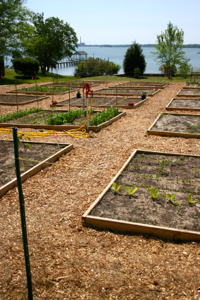
Conroy says the site offers an ideal location with level ground, good drainage, eight or more hours of sun per day, and accessibility to water. The area also provides room for future growth. The 37 cubic yards of topsoil and compost needed to fill the raised beds—on what is otherwise a sandy site—were purchased from Green Planter’s Garden and Landscape Nursery in Hayes.
The garden sits on a site previously occupied by Geddings House, one of the older single-family dwellings demolished in 2011 as part of VIMS’ efforts to save energy and green its campus.
Composting
The VIMS campus in Gloucester Point is mostly underlain by sand, with little organic matter for plant growth. Thus a second part of the garden project is to create compost that can be used to fertilize and improve the soil within the garden plots.
“Although we have no dining areas or a cafeteria,” says Conroy, “we do still create a fair amount of vegetable waste during lunch hour and from campus events. To capture that waste we’ve set aside one eight by eight plot as a compost pile where members of the VIMS community can bring their compostable foods as well as grass clippings or other yard waste.”
Rain Barrels
A third goal of the garden project is to deploy several rain barrels to collect water from the roof of nearby buildings. The aim is to reduce the amount of runoff entering the York River while providing an extra source of water for the garden.
Luek says “Relying on this collected water as much as possible, rather than water treated by the county, will reduce the amount of water that must be purified through a treatment plant, saving both electricity and transport costs.”
“Overall,” she says, “We hope this garden will increase the sustainability of our campus, help people focus on the source of their food, and provide a greater sense of community.”
Luek notes these objectives echo VIMS’ broader institutional goals. “If we want Chesapeake Bay to continue to be a source of seafood, we need to work together ensure that it is treated well,” she says.
Stone echoes that sentiment. “A cleaner Bay and ocean can’t be achieved by research or changes in policy alone—education and personal changes in how we live our lives are also important. Gardening is one important step that helps to reduce our impact on the Bay’s ecosystems, and sets a good example for others to follow.”

